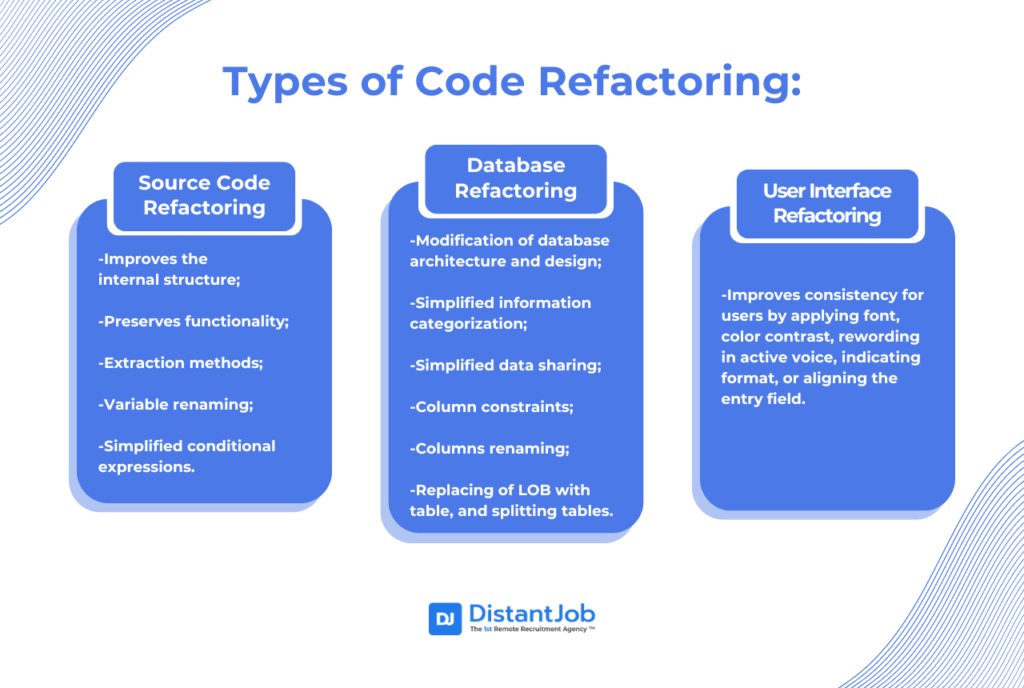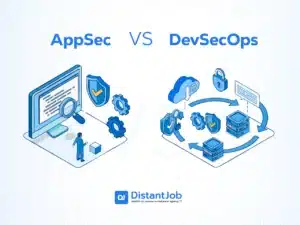Have you ever looked at code that’s running wonderfully (at least hopefully), but is so hard to read and simply a pain to manage? The magic solution is called code refactoring. Code refactoring is the process of testing and restructuring your code without affecting its functionality.
One of the first promoters of this method is Martin Fowler. As the ‘Father of Refactoring, ’ he collected the pros and tips of this methodology in the book Refactoring: Improving the Design of Existing Code.
As a leader, it can be hard to justify taking time away from pressing deadlines to focus on improving the code, but refactoring keeps code readability and structure, simplifies quality assurance, and ultimately makes future changes easier. In the long run, this saves you time and money by reducing maintenance headaches and keeping your project agile.
In this comprehensive guide, we’ll get into the nitty-gritty of software refactoring, the advantages of code refactoring, the misconceptions about code refactoring, and time-tested, best practices and techniques.
Benefits of Refactoring Your Code
While you might think that code refactoring will require precious tech time that is needed elsewhere, code refactoring can save you a lot of headaches and is quite possibly the best investment you can make in your software.
Refactoring should be an integral part of the entire development process. By rewriting and organizing the code, the code becomes more readable and thus easier to maintain. Your team will better understand the code during the onboarding process.
Bug fixing will be less complicated and new features will integrate easier. This means that one of the worst side effects of code refactoring, called technical debt will be drastically diminished (less time will be needed debugging the code). Developers claim that 30% of the time will be saved on bug fixes if organizations regularly maintain code refactoring.
The result is a faster software development life cycle. Code refactoring will make developers work faster and diminish the chance the code will get stuck, breaking the continuous integration (automated testing) process.
Types of Code Refactoring

Source Code Refactoring. Focuses on improving the internal structure of the code while preserving its functionality. Techniques include extracting methods, renaming variables, and simplifying conditional expressions.
Database Refactoring. Allows modification of the database architecture and design to simplify information categorization and data sharing. Tools include introducing column constraints, renaming columns, replacing LOB with table, and splitting tables.
User Interface Refactoring. A method that refers to the software’s user interface (UI) and helps improve consistency for users by applying font, color contrast, rewording in active voice, indicating format, or aligning the entry field.
Effective remote code refactoring can be a great asset in scaling your business over time. However, is it the right strategy for any business? When would be the ideal time to refactor your software code?
Best Refactoring Code Practices for Developers
As any business is unique, it’s essential to determine when to implement different methods and how different practices can help your business. Introducing a different method too soon or too late can only result in losing time and resources for you and your team.
Adopting code refactoring best practices is crucial to reaping the maximum benefits while minimizing disruption.
Here are the main code refactoring methods:
1. Red-Green-Refactor
As an integral part of test-driven development (TDD), this method allows writing tests before code scripts and consists of three steps:
In the first step, developers write failing tests to expose issues or required functionalities. This stage allows identifying bugs or missing functionalities to implement in the future.
After the red stage, developers add in the script the code required to pass the test implementing quality or maintainability of the code.
Finally, when the test is green, developers can refactor the script to clean the code and maintain the software over time.
This system helps a development team in structuring deadlines and priorities, setting tasks and shared channels to track and monitor updates and changes. With this type of organization, your dev team can avoid useless conversation, and focus on the technical features of your project.
2. Refactoring by Abstraction
Refactoring by abstraction allows for identifying common functionality in multiple classes and extracting data into a separate class or interface. Avoiding code duplication improves reusability and maintains shared functionalities. When you hire new developers, this method helps you maintain a good performance and work paste, avoiding looking for new script or replicating work already done.
3. Composing
Composing refers to breaking down large classes into more manageable components. It improves readability and testability by dividing single responsibilities for each component. Your developers can make changes faster, and share their updates in an understandable way for the rest of your team.
4. Simplifying Methods
Simplifying methods literally means reducing code complexity to implement readability and maintenance within different departments. It includes strategies like reducing method parameters, replacing complex conditional logic constructs, or breaking down long classes. This method allows different departments, like sales or marketing, in following the product development process and create more effective strategies to grow your remote company.
5. Moving Features Between Objects
This technique improves how classes’ responsibilities are related and helps reduce coupling code and duplications. As for abstraction, this method is particularly useful for remote and distributed teams working at different times.
6. Preparatory Refactoring
This technique allows creating more adaptable structures without impacting users’ interfaces when preparing changes or new features for the codebase. If you run an e-commerce or online services, this technique helps you maintain your services active for the users, while your developers can make changes at any time.
The bottom line of these techniques is to make your coding scripts cleaner, more understandable, and adaptable to change.
To recap, here are the benefits of code refactoring for remote development teams:
1. Cleaner Code
In remote teams, clean code translates into quicker communication and faster performance. Your developers don’t need to constantly ping each other to find out information or new accesses to code, implementing your performance in the long run.
2. Improved System Design
In running a business selling online services, you need to provide an easy experience for your users. Code refactoring allows you to implement your UX experience, implementing what you already have rather than creating everything again.
3. Seamless Product Enhancement
As we said, with code refactoring techniques you can improve your code architecture without stopping your services. This characteristic is particularly useful for remote business working on different time zones, as your developers can adjust code and features at any time.
4. Resources and Time Consumption Reduction
With different tests and prototypes, this method helps you understand where to target your team resources, and how to benefit from different time zones and remote teams.
5. Implemented Software Productivity and Performance
By reducing code complexity and breaking down classes, you can better organize tasks and priorities, implementing specific features organically to increase your productivity.
6. Defined software metrics and KPIs
As you can schedule tests and product launches, code refactoring techniques facilitate you setting clear metrics and KPIs to keep your remote teams on the same page.
The Benefit of Code Refactoring Tools for Your Business

For a growing and expanding business, code refactoring can be an effective strategy, especially when:
1. Scaling Your Software
When to use: Your product needs new features or changes to meet evolving customer demands.
Why it works: Refactoring allows you to quickly modify your software while maintaining user access and experience.
Pro Tip: Regular refactoring sprints can keep your codebase flexible and ready for growth.
2. Tackling Technical Debt
The problem: Post-launch activities can accumulate, leading to bugs and slower performance.
The solution: Refactoring helps clear out these issues, ensuring your code remains efficient and bug-free.
3. Upgrading Cost-Efficiently
The challenge: Complex code structures and bugs can impact your services and performance.
The benefit: Clean, refactored code is easier to maintain over time, reducing long-term costs.
A report by Cisco Systems indicated that regular code reviews improve overall code quality by 20-30%, leading to easier maintenance and lower long-term costs.
4. Enhancing Code Readability
Why it matters: As your team grows or changes, new members need to quickly understand and work with your codebase.
The impact: Readable code speeds up onboarding and prevents slowdowns in service and product development.
5. Boosting Team Collaboration
Key elements:
- Clean code
- Clear team roles
- Optimized software architecture
Result: These factors are crucial for maintaining high performance in remote teams.
6. Supercharging Performance
What happens: Optimized code runs faster and uses fewer resources.
The long-term benefit is an improved overall system performance and scalability.
After refactoring, some companies report up to 50% improvement in application response times.
Challenges of Refactoring Code in Distributed Teams
While code refactoring offers significant benefits for remote businesses, it’s crucial to be aware of the challenges it presents, especially for offshore teams. Here’s what you need to watch out for:
1. Limitations of Automated Tools
Refactoring tools can clean up code, but they can’t automatically fix all bugs or loopholes.
The solution is to combine automated tools with manual review and testing. This hybrid approach ensures thorough code improvement. Use tools like SonarQube for automated code quality checks, but always follow up with human oversight.
2. Time and Resource Management
Without a clear roadmap, refactoring can become a time sink, distracting developers from other crucial tasks.
The solution is to develop a structured refactoring plan with specific timelines and resource allocation. For example, dedicate 20% of sprint time to refactoring tasks, ensuring continuous improvement without neglecting new features.
3. Lack of Clear Objectives
Undefined goals can make refactoring overwhelming and potentially counterproductive.
Establish clear, measurable objectives for each refactoring effort to solve the problem
Checklist:
- Define specific code quality metrics to improve
- Set deadlines for each refactoring phase
- Align refactoring goals with overall project objectives
4. Communication Hurdles in Remote Teams
Ofsshore developers may struggle to effectively discuss and align on refactoring decisions.
By implementing robust communication channels and protocols specifically for refactoring efforts, you can solve the challenges of communication.
Try to schedule regular “Refactor Sync” meetings to discuss progress, challenges, and next steps.
5. Version Control Complexities
Managing simultaneous refactoring efforts across different branches can be tricky.
The solution is to implement clear branching strategies and use advanced version control features.
Tools to Consider:
- Git Flow for structured branching
- Pull requests for code review before merging
6. Ensuring Code Quality Post-Refactoring
Without comprehensive testing, refactoring might introduce new bugs.
You can improve it by having rigorous automated testing alongside refactoring efforts.
Key Components:
- Unit tests for individual components
- Integration tests for system-wide functionality
- Continuous Integration (CI) pipeline to catch issues early
7. Coordinating Across Time Zones
Different time zones can complicate the coordination of refactoring efforts.
But with the help of asynchronous collaboration tools and establishing clear handoff procedures, you can easily solve the issue.
Strategies:
- Use tools like Asana or Trello for task tracking
- Implement detailed code documentation for smooth handovers
- Establish overlapping work hours for critical discussions
So, when should we avoid refactoring in remote teams?
If you run a startup or a new business, and are writing code from scratch, this method is not effective. You first need to stabilize your team and practices, rather than create a system that is too complex for your team to handle.
Furthermore, when you have a close deadline for products’ launch, code refactoring will translate into a waste of time and resources. Once it is set, the method has several benefits. But to adjust your team structure you need time and coordinations, and it’s best to think of these implementations when the product has been launched.
To recap, code refactoring is a great tool, but it’s important to coordinate with your team to optimize your resources at the right time.
Refactoring for Results: Streamlining Code and Collaboration in Remote Teams
As your startup scales, optimizing your codebase becomes crucial for sustainable growth. Code refactoring isn’t just about cleaning up—it’s a strategic tool for cost-effective product development, especially in remote teams. Whether you’re expanding your e-commerce platform or scaling your SaaS offering, mastering refactoring can give your startup a competitive edge
Here are the key steps to ensure your remote team executes refactoring with precision and purpose:
- Communicate Effectively
Communication is always key, especially in development teams. First, it’s important to set regular meetings and check-ins to ensure everyone is on the same page. Besides virtual meetings, set up specific communication channels to share adjustments and changes, deadlines and tasks.
- Define Clear Objectives
What do you need refactoring code for? Clean the script and speed up your software? Change database structures while keeping your services active? Define your goals, and prioritize tasks accordingly not overwhelm your team.
- Roles and Responsibilities
Assigning roles and responsibilities is necessary to implement code refactoring. You can select one person to refer to, and clearly divide roles to avoid miscommunication or extra meetings.
- Collaborate on Code Reviews and Version Control Systems
Code reviews are one of the best methods to check scripts and save time for your developers, and it also helps improve communication. Alongside code reviews, implement version control systems like Git to implement track changes and allow simultaneous code changes.
Conclusion
Code refactoring is a powerful tool for maintaining and improving software quality, especially for remote teams working on complex, evolving projects. By understanding when and how to implement refactoring techniques, teams can significantly enhance their codebase’s maintainability, scalability, and overall quality. Effective refactoring is ongoing. It demands commitment, clear communication, and a firm grasp of design principles. And this can be done when you have the right team.
Remember that the best strategy for a productive and efficient team is to recognize your team’s hard work and select the best candidates in the first place. Even the best developer will lack effort with poor management or the wrong team members. Here at DistantJob, wecan help you with this stage. Our recruitment team is well-trained in picking global talent and recognizing which candidate will best fit with your company culture. And you can keep focusing on your growing business and improving your code! Just book a call and learn more!





